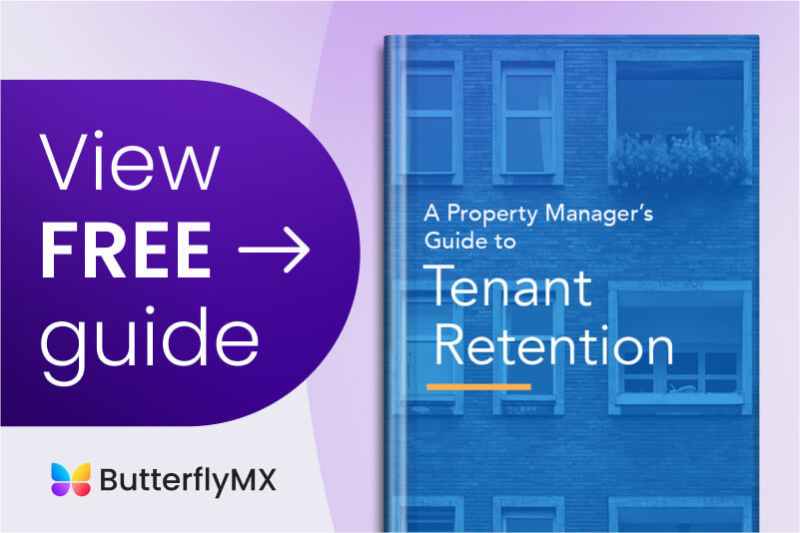Key takeaways
- Long-term tenants are one of the most prized relationships a property manager can establish.
- By maintaining a relationship with a long-term tenant, you’ll avoid the uncertainty and costs that come with finding new, short-term tenants.
- While long-term tenants are good to have, keeping a renter happy enough to renew their lease requires some action on your part.
- To keep a long-term resident, you should emphasize communication and community by quickly responding to maintenance requests, checking in with your tenants before their lease expires, and establishing ways to make your building feel like home.

As a property manager, retaining residents is one of the most important parts of your job. Searching for new tenants involves marketing and administrative responsibilities, on top of your other property management duties. It’s almost a separate job on its own.
So how can you cut down on this time-consuming search while making your job as a property manager easier? The answer is simple: Finding and retaining long-term tenants who opt for long-term leases instead of short-term leases.
In this post, we explain what long-term tenants are and why it’s worth retaining residents long-term. Then, we give you some tips on how to retain tenants longer.
This post covers:
- What is a long-term tenant?
- What are the benefits of long-term tenants?
- 3 ways to attract long-term tenants?
What is a long-term tenant?
A long-term tenant is a resident who has chosen to extend their lease past its original terms. In contrast to a short-term resident, who only stays for the shortest amount of time that their lease allows, you have the opportunity to form a lasting, healthy relationship with a long-term tenant.
A long-standing tenant might choose to stay at your property for many different reasons. Long-term leases are a great way for a tenant to get to know a community without taking the massive step of buying a house. Anything from a school district to a new job might encourage a resident to put down roots in the neighborhood and become a long-term tenant.
However, a tenant who wants to stay in the area isn’t guaranteed to stick with your building for the duration of their stay. Long-term tenants will extend or renew their leases because they enjoy their relationships with property managers, building staff, and the property itself.
Watch how ButterflyMX works:
What are the benefits of long-term tenants?
When you compare a long-term apartment tenant to a series of short-term tenancies, the benefits of retaining a long-term tenant quickly become apparent.
The benefits of long-term rentals include:
- A consistent stream of income. When a renter leaves, you’ll have to restart the arduous process of replacing them. This involves marketing your property and keeping up with negotiations, tours, and paperwork for multiple potential tenants —and all the while, your apartment unit will be empty for months. Instead of dealing with all of those costs & hassles, you can find the right long-term tenant and limit the time your apartment units sit vacant.
- Saving money on move-ins. While finding tenants is a task in and of itself, preparing units for new renters is also a time-consuming task. Moving a renter out involves paperwork on your end and a deep clean in preparation for a new resident. And onboarding a new tenant involves more paperwork, reviewing applications, and screening or running background checks on tenants. A lack of long-term tenants doesn’t just mean you don’t make money; it means you actively lose money on large portions of the tenant search process.
- No uncertainty about a new tenant’s habits. When you approve a new resident, you’re taking on a risk. You can’t be certain that the new resident will be reliable, respectful, or pay rent on time. However, if you’ve found a good tenant, you can put all those questions to rest.
3 ways to attract long-term tenants?
While it may be easier to retain long-term tenants at horizontal multifamily properties, it can be done at traditional, vertical properties with the right efforts. Here are some tips that will help you retain tenants for the long term.
Here are three ways to attract and keep long-term tenants:
- Respond to maintenance requests in a timely manner
- Check in with your tenant before their lease expires
- Foster a community

1. Respond to maintenance requests in a timely manner
While repairs and maintenance are nearly unavoidable, this doesn’t mean that a renter will have issues with your property as a whole. Being prompt, courteous, and available to fix any maintenance issues could be the difference between a tenant staying for another year or a resident moving out in search of a more responsive property manager.
2. Check in with your tenant before their lease expires
Checking in with your tenant shows that you value them and are putting effort into retaining them. If you plan to check in, do so well before their lease expires by sending a lease renewal notice. That way, you give your resident enough time to make a decision. And if they decline to renew their lease, you’ll also have ample time to begin searching for a new tenant.
This check-in is also a great opportunity for you to foster a relationship with the resident and persuade them into renewing their lease. For example, you’ll be able to offer incentives like discounted rent, which will increase your standing in the eyes of any long-term renter.
3. Foster a community
While you might be able to offer a renter financial incentives to renew their lease, there are some things that money just can’t buy. By doing your part to create community and familiarity among tenants and property managers, you can foster feelings of friendship and make your building feel like home.
For example, consider hosting events for residents. You can also give your residents opportunities to make local connections by starting a bulletin or email chain that alerts tenants to local community events. Finally, consider reaching out to residents during holidays, birthdays, or other significant dates to provide a human touch.






